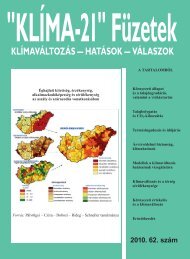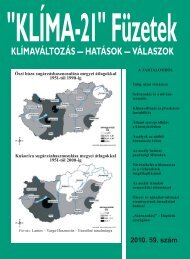KLÃMA-21 Füzetek 61. szám - VAHAVA Hálózat
KLÃMA-21 Füzetek 61. szám - VAHAVA Hálózat
KLÃMA-21 Füzetek 61. szám - VAHAVA Hálózat
Create successful ePaper yourself
Turn your PDF publications into a flip-book with our unique Google optimized e-Paper software.
192 „KLÍMA-<strong>21</strong>” FÜZETEK: KLÍMAVÁLTOZÁS – HATÁSOK – VÁLASZOK<br />
EFFECT OF CLIMATIC VARIABILITY<br />
ON THE RESTORATION SUCCESS OF OPEN SANDY GRASSLANDS<br />
By<br />
TÖRÖK, KATALIN – LOHÁSZ, CECÍLIA – SZITÁR, KATALIN<br />
Keywords: drought index, life form strategies, climate change, mowing, aridification.<br />
Drought periods are a major reason of vegetation stress in the Hungarian lowland. The effect<br />
of climate was investigated in relation to life form traits in a restoration project aiming to restore<br />
endemic grassland community in former black locust plantations. Black locust plantations are<br />
species poor habitats and respresent a threat to biodiversity by invading surrounding seminatural<br />
habitats. After clear-cutting of black locust plantations, resprouting was hindered by chemical<br />
treatment, while weed abundance was decreased by mowing and hay removal. The vegetation of<br />
the treated and of the control plots became different over the 8 years, but composition and species<br />
abundance were still far from the target endemic grassland community (Festucetum vaginatae)<br />
by 2003. Increased drought resulted in lower vegetation cover in both the control and the treatment<br />
plots. Species in different life form groups responded differently. Negative correlation was<br />
found between the abundance of spring annuals and perennial monocots with drought, while the<br />
correlation between perennial dicots and summer annuals with drought was positive. Only summer<br />
annuals showed different sensitivity in the control and the treatment plots (not significantly),<br />
as drought resulted in higher cover in mowed plots. This is not necessarily a response to less precipitation,<br />
as reduced competition and increased open space can also contribute to higher cover.<br />
Altogether it was found that the share of different species groups and their response to drought<br />
contributed to different vegetation development in the control and the treatment plots.<br />
IMPACT OF CLIMATE CHANGE ON AMPHIBIANS<br />
By<br />
PUKY, MIKLÓS<br />
Keywords: climate change, amphibians, Hungarian observations.<br />
Climate change increasingly threatens several animal groups, primarily aquatic or semiaquatic<br />
species, such as amphibians, which have small migration radius and complex habitat<br />
requirements. Long term data sets indicate that recent climate changes influence the distribution,<br />
survival, extinction, morphology and reproduction biology of certain species. Several<br />
observations are available on population size changes and successful colonisation of new<br />
areas due to weather-dependent factors in Hungary. Besides, the green toad (Epidalea viridis)<br />
was recorded to have two successful reproductive cycles within a year in 2008, which had<br />
not been recorded before. The limited information available suggests that long-term study<br />
of all amphibian species in different habitat types is called for to describe climate-induced<br />
alterations in order to provide a firm basis for future conservation interventions if necessary.






